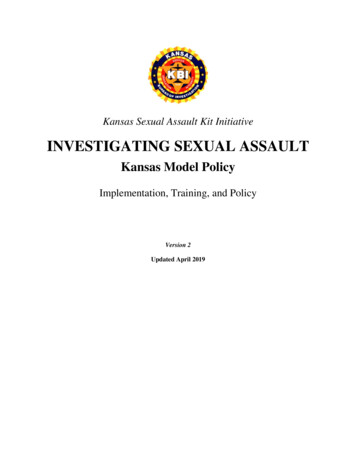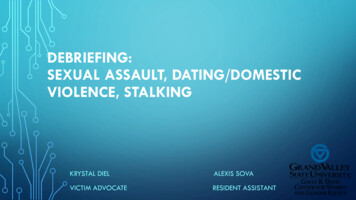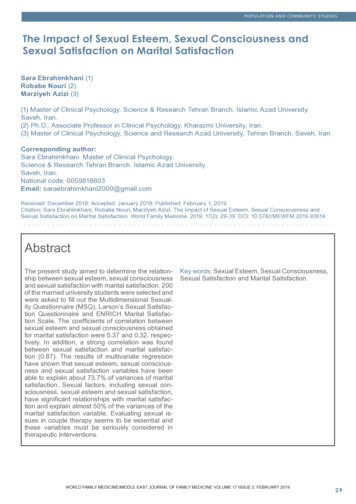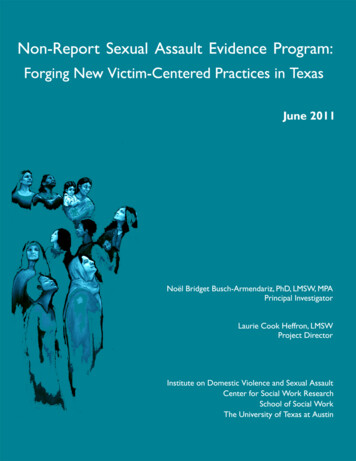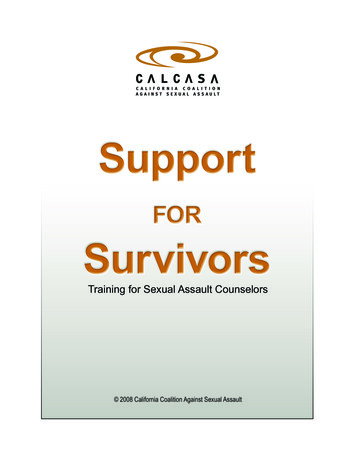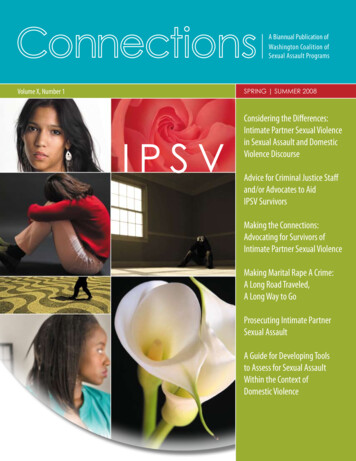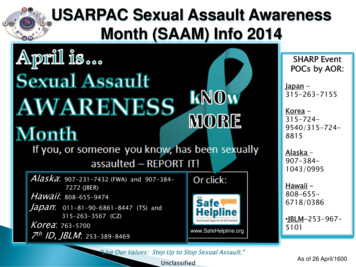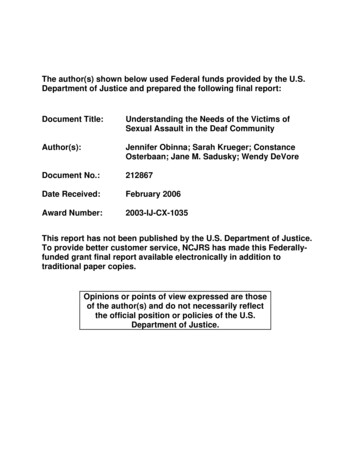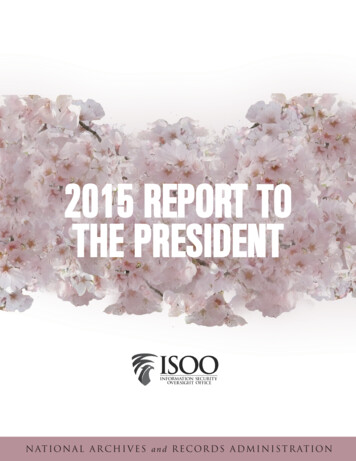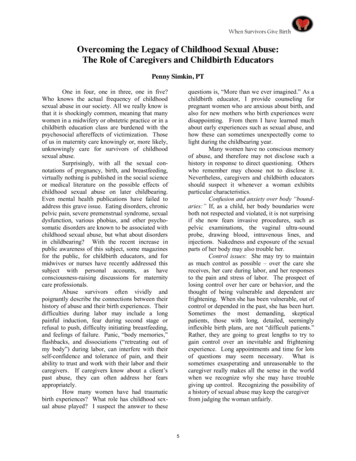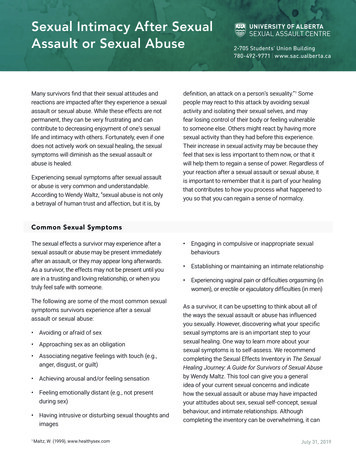
Transcription
Sexual Intimacy After SexualAssault or Sexual AbuseMany survivors find that their sexual attitudes andreactions are impacted after they experience a sexualassault or sexual abuse. While these effects are notpermanent, they can be very frustrating and cancontribute to decreasing enjoyment of one’s sexuallife and intimacy with others. Fortunately, even if onedoes not actively work on sexual healing, the sexualsymptoms will diminish as the sexual assault orabuse is healed.Experiencing sexual symptoms after sexual assaultor abuse is very common and understandable.According to Wendy Waltz, “sexual abuse is not onlya betrayal of human trust and affection, but it is, by2-705 Students’ Union Building780-492-9771 www.sac.ualberta.cadefinition, an attack on a person’s sexuality. ”1 Somepeople may react to this attack by avoiding sexualactivity and isolating their sexual selves, and mayfear losing control of their body or feeling vulnerableto someone else. Others might react by having moresexual activity than they had before this experience.Their increase in sexual activity may be because theyfeel that sex is less important to them now, or that itwill help them to regain a sense of power. Regardless ofyour reaction after a sexual assault or sexual abuse, itis important to remember that it is part of your healingthat contributes to how you process what happened toyou so that you can regain a sense of normalcy.Common Sexual SymptomsThe sexual effects a survivor may experience after asexual assault or abuse may be present immediatelyafter an assault, or they may appear long afterwards.As a survivor, the effects may not be present until youare in a trusting and loving relationship, or when youtruly feel safe with someone.The following are some of the most common sexualsymptoms survivors experience after a sexualassault or sexual abuse: Avoiding or afraid of sex Approaching sex as an obligation Associating negative feelings with touch (e.g.,anger, disgust, or guilt) Achieving arousal and/or feeling sensation Feeling emotionally distant (e.g., not presentduring sex) Having intrusive or disturbing sexual thoughts andimages1Maltz, W. (1999), www.healthysex.com Engaging in compulsive or inappropriate sexualbehaviours Establishing or maintaining an intimate relationship Experiencing vaginal pain or difficulties orgasming (inwomen), or erectile or ejaculatory difficulties (in men)As a survivor, it can be upsetting to think about all ofthe ways the sexual assault or abuse has influencedyou sexually. However, discovering what your specificsexual symptoms are is an important step to yoursexual healing. One way to learn more about yoursexual symptoms is to self-assess. We recommendcompleting the Sexual Effects Inventory in The SexualHealing Journey: A Guide for Survivors of Sexual Abuseby Wendy Maltz. This tool can give you a generalidea of your current sexual concerns and indicatehow the sexual assault or abuse may have impactedyour attitudes about sex, sexual self - concept, sexualbehaviour, and intimate relationships. Althoughcompleting the inventory can be overwhelming, it canJuly 31, 2019
Sexual Intimacy After SexualAssault or Sexual Abusehelp you understand how your sexuality has beenimpacted by the abuse. Many of the effects of thesexual assault or abuse that influence your sexualityare a result of the s exual abuse mind set . In general,this mind set consists of false beliefs about sex and theexperiences survivors of sexual assault or abuse face.These false beliefs typically develop when there is2-705 Students’ Union Building780-492-9771 www.sac.ualberta.caconfusion between the sexual assault/abuse and sex.It is important to remember that while sexual activitywas a part of the sexual assault or abuse, it was nothealthy sex. It was not consensual and the perpetratorused sexual activity to gain power over you, making itabusive sex.Sexual AttitudesThe following table summarizes the differences between healthy sexual attitudes versus attitudes related tosexual abuse2:2Sexual Abuse Mind-set (sex sexual abuse)Healthy Sexual Attitudes (sex positive sexual energy)Sexual is uncontrollable energySex is controllable energySex is an obligationSex is a choiceSex is addictiveSex is a natural driveSex is hurtfulSex is nurturing, healingSex is a condition for receiving loveSex is an expression of loveSex is “doing to” someoneSex is sharing with someoneSex is a commoditySex is part of who I amSex is void of communicationSex requires communicationSex is secretiveSex is privateSex is exploitativeSex is respectfulSex is deceitfulSex is honestSex benefits one personSex is mutualSex is emotionally distantSex is intimateSex is irresponsibleSex is responsibleSex is unsafeSex is safeSex has no limitsSex has boundariesSex is power over someoneSex is empoweringMaltz, W. (2001). The Sexual Healing Journey: A Guide for Survivors of Sexual Abuse. New York: Harper Collins.July 31, 2019
Sexual Intimacy After SexualAssault or Sexual Abuse2-705 Students’ Union Building780-492-9771 www.sac.ualberta.caHealthy Sexual Attitudes and ReactionsThe passing of time and positive sexual experiencesby yourself or with a partner will naturally move youtowards more healthy sexual attitudes.You can also begin the process of shifting your ideasof a sexual abuse mind set to healthy sexual attitudesby practicing some of the following strategies: 3Avoiding exposure to people and things thatreinforce the sexual abuse mind set, includingany media that portrays sex as sexual abuse. Forexample, pornography consistently depicts sexuallyaggressive and abusive situations as pleasurableand consensual. Alternatives to pornographyinclude erotic materials where the sexual situationsinvolve consent, equality and respect.Ensuring that your language about sex reflects thatsex is something positive and healthy, and that itis something that you can make choices about.For instance, using positive and accurate languagewhen referring to sex and body parts as opposed tousing slang or terms that are negative, degrading,or reinforce the idea that sex is sexual abuse (e.g.,“banging” or “nailing”).Discovering more about your current sexualattitudes and how you want them to change. Thisreflection could include, for example, how youwould feel about sex if you had never been sexuallyassaulted or abused, and how you want to thinkand feel about sex in the future.Discussing ideas about healthy sexuality andsex with others, including talking to your friends,partner, therapist, and/or support group members.Educating yourself about healthy sex (e.g.,reading books, taking workshops, or talking with acounsellor).As well, many people find it empowering to know theirsexual rights as outlined in the Bill of Sexual Rights3:Bill of Sexual Rights I have a right to develop healthy attitudesabout sex. I have a right to receive accurate sexualinformation. I have a right to sexual privacy. I have a right to protection from bodilyinvasion or harm. I have a right to my own feelings, beliefs,opinions, and perceptions about sex. I have a right to set my own sexual limits. I have a right to say no to sexual behavior. I have a right to experience sexual pleasure. I have a right to be in control of my sexualexperience. I have a right to control touch and sexual contact. I have a right to stop sexual arousal that feelsinappropiate or uncomfortable. I have a right to develop my sexualityaccording to my sexual preferences andorientation. I have a right to have a loving partner. I have a right to a partner who respectsme, understands me, and is willing tocommunicate with me about sex. I have a right to talk to my partner about mysexual assault and/or sexual abuse. I have a right to enjoy healthy sexual pleasureand satisfaction.Maltz, W. (2001). The Sexual Healing Journey: A Guide for Survivors of Sexual Abuse. New York: Harper Collins.July 31, 2019
Sexual Intimacy After SexualAssault or Sexual Abuse2-705 Students’ Union Building780-492-9771 www.sac.ualberta.caC.E.R.T.S. Healthy Sex ModelTo determine if you are about to engage in healthysex, ask yourself if your current situation meets all ofthe requirements found in the C.E.R.T.S. Healthy SexModel4:CONSENT : Can I freely and comfortably choosewhether or not to engage in the sexual activity? Am Iable to stop the activity at any time during the sexualcontact?EQUALITY : Is my feeling of personal power on anequal level with my partner? Do either of us dominatethe other?I feel supported by my partner and am I supportive ofthem?TRUST : Do I trust my partner on a physical andemotional level? Do we have a mutual acceptance ofvulnerability and an ability to respond to each other withsensitivity?SAFETY : Do I feel secure and safe within the sexualsetting? Am I comfortable with and assertive aboutwhere, when and how the sexual activity takes place?Do I feel safe from the possibility of unwantedpregnancy and/or STIs?RESPECT : Do I have a positive regard for myself andfor my partner? Do I feel respected by my partner? DoEngaging in Healthy Sexual ActivityFor many people, it is essential to take a break fromsexual activity at some point in their healing. Takinga break from sexual activity is an important optionfor survivors, regardless of how long they havebeen in a relationship and whether or not they aremarried or common-law. As a survivor, this breakis an opportunity for you to consider your ownsexuality without concerning yourself with someoneelse’s sexual desires. It also ensures that your timeand energy are focused on healing as opposed toworrying about sex or sexual advances.after a long period away from your partner, on youranniversary or on other special occasions). Take an active role in your sexual activity bycommunicating to your partner how you are feeling,what your preferences and desires are, what youdon’t like, or what makes you uncomfortable. Give yourself permission to say no to engaging insexual activity at any time, even after you initiatedor consented to the sexual activity.When you decide to be sexually intimate withsomeone, challenge yourself to take some of thefollowing steps: 4Engage in sexual activity when you really wantto, not when you feel you should want to (e.g.,Maltz, W. & Holman, B. (1991). Incest and Sexuality: A Guide to Understanding and Healing. Lanham: Lexington Books.July 31, 2019
Sexual Intimacy After SexualAssault or Sexual Abuse2-705 Students’ Union Building780-492-9771 www.sac.ualberta.caEstablishing Guidelines Around Sexual ActivityIt can also be helpful to discuss guidelines aboutyour shared sexual intimacy as a way to help you feelsafer during sexual encounters, and set ground rulesthat make you both feel more comfortable.The following guidelines outlined in the Healthy SexTrust Contract are examples you can use in your ownrelationship:other unless we want to reveal them. We don’t have to disclose the details ofa previous sexual relationship unless thatinformation is important to our presentpartner’s physical health or safety. We can initiate or decline sex withoutincurring a negative reaction from our partner. We each agree to be sexually faithful unlesswe have a clear, prior understanding that it’sokay to have sex outside the relationship (thisincludes virtual sex, such as phone or internetsex). We will support each other in minimizingrisk and using protection to decrease thepossibility of disease and/or unwantedpregnancy. We will notify each other immediately ifwe have or suspect we have a sexuallytransmitted infection. We will support each other in handling anynegative consequences that may result fromour sexual interactions.The HealthySex Trust Contract5 It’s okay to say no to sex at ANY TIME. It’s okay to ask for what we want sexually,without being teased or shamed for it. We don’t ever have to do anything we don’twant to do sexually. We will take a break or stop sexual activitywhenever either of us requests it. It’s okay to say how we are feeling or what weare needing at ANY TIME. We agree to be responsive to each other’sneeds for improving physical comfort. What we do sexually is private and not to bediscussed with others outside our relationshipunless we give permission to discuss it. We are ultimately responsible for our ownsexual fulfillment and orgasm. Our sexual thoughts and fantasies are our ownand we don’t have to share them with eachOnce you and your partner have agreed on a set ofguidelines, you can also discuss what the potentialconsequences will be if one of the guidelines is notrespected.Automatic Reactions to TouchEven after you have set up guidelines to make sexualactivity feel safer, you may still experience automaticreactions to touch. These reactions might include5Maltz, W. (1999), www.healthysex.comflashbacks, panic attacks, a sense of sadness and/orfear, dissociation, nausea, pain, or freezing. Thoughthese reactions are unwanted and upsetting to bothJuly 31, 2019
Sexual Intimacy After SexualAssault or Sexual Abuseyou and your partner, with time and healing they willminimize in frequency and severity.In order to gain control of your body and mindduring an automatic reaction, refrain from all sexualactivity. It’s important to take the time you needto acknowledge that you are having an automaticreaction, and to consider what triggered it. Takesome time to self-soothe, feel safe, pay attentionto your breathing, and bring your mind and bodyback to the present by reorienting yourself toyour surroundings (e.g., try to take slow, deepbreaths). Remind yourself that you are no longerliving the sexual assault or abuse and use yourdifferent senses to become aware of your currentenvironment. For example, what do you see andhear? You can also touch some of the objects around2-705 Students’ Union Building780-492-9771 www.sac.ualberta.cayou to ground yourself to the present.As well, take time to rest and recover after youexperience an automatic reaction as they can be bothphysically and mentally overwhelming. When youare ready, think about what triggered your automaticreaction, and how you could alter the situation so thatthe trigger does not happen or does not affect you inthe same way. Examples of how you can help yourselfcould include changing the set up of the room, askingyour partner to watch for signs that you are havingan automatic reaction, and stopping the activityyou believe is causing your trigger. Also, if you arebeing triggered while intimate with a partner, discusswhat you would like them to do when you have anautomatic reaction (e.g. stop what they are doing, holdyou, talk to you, sit with you, etc.).Relearning TouchMany survivors of sexual assault or abuse interpretsexual touch or sexual activities as negative andunpleasant. However, through specific therapeuticexercises with yourself and/or a partner, you can learnto enjoy and feel safe during sexual touch.6Building emotional trust and a sense of safety in arelationship are important prerequisites to enjoyingsexual intimacy. If you are in a partnership while youare beginning to heal sexually, it is important thatyou work with and include your partner in the healingprocess. Feeling safe and comfortable with yourpartner, and making sure your partner respects yourlimits benefits both of you. Partners who act in waysthat mimic sexual assault or abuse (e.g., touchingwithout consent, ignoring how you feel, or behavingin impulsive or hurtful ways) will prevent you fromhealing.ConclusionThe process of sexual healing is slow, and worksbest if it coincides with other healing approachesthat focus on assault or abuse. Fortunately, withtime and efforts made towards your healing process,the effects that a sexual assault or abuse canhave on your ability to enjoy sexual intimacy canbe minimized. For example, receiving counselling6throughout the healing process is beneficial, and isoften recommended to manage triggers of difficultmemories and emotions. While sexual healing is aprocess that can take time and energy on your part(and possibly that of your partner and loved ones),it can lead to experiencing consistent, positive, andpleasurable sexual intimacy.Maltz, W. (2001). The Sexual Healing Journey: A Guide for Survivors of Sexual Abuse. New York: Harper Collins.July 31, 2019
Sexual Intimacy After SexualAssault or Sexual Abuse2-705 Students’ Union Building780-492-9771 www.sac.ualberta.caAdditional Resources Davis, L. & Bass, E. (2008). The Courage to Heal: A Guide for Women Survivors of Child Sexual Abuse. New York:Collins Living. Haines, S. (1999). The Survivor’s Guide to Sex: How to Have an Empowered Sex Life After Child Sexual Abuse. SanFrancisco: Cleis Press. Lew, M. (2004). Victims No Longer: The Classic Guide for Men Recovering from Sexual Child Abuse. HarperPerennial. Maltz, W. (1987). Incest and Sexuality: A Guide to Understanding and Healing. England: Lexington Books.July 31, 2019
Educating yourself about healthy sex (e.g., reading books, taking workshops, or talking with a counsellor). As well, many people find it empowering to know their sexual rights as outlined in the Bill of Sexual Rights 3: Healthy Sexual Attitudes and Reactions Bill of Sexual Rights I have a right to develop healthy attitudes about sex.
